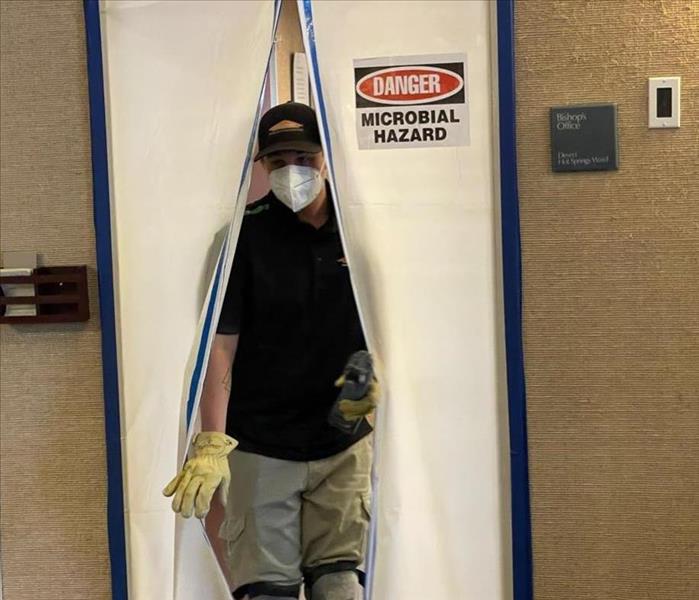Understanding Mold Remediation Services: Find the Source to Make Your Home or Business Comfortable
6/4/2023 (Permalink)
When it comes to dealing with mold in your home, it's essential to differentiate between mold removal and mold remediation. Mold removal involves physically eliminating mold spores, while mold remediation focuses on restoring mold levels to normal, natural levels. Nowadays, many mold remediation companies claim to remove all mold from your home, but that's simply not possible. Mold spores are ubiquitous, making 100% mold removal an unrealistic goal, regardless of your location. Mold remediation and mold removal are often used interchangeably in the industry. However, complete mold removal is unattainable due to the microscopic nature of airborne mold spores, which can be found both indoors and outdoors.
Signs of Mold in Your Home
Mold that is not visible to the naked eye can go unnoticed until you start experiencing mold-related symptoms such as coughing, watery eyes, a runny nose, or sudden congestion. If these symptoms disappear when you leave your home, it's likely that indoor mold is the culprit. This becomes a concern because certain molds can be toxic to both humans and pets. Severe cases of mold infestation can lead to life-threatening illnesses, severe asthma attacks, and even neurological problems.
Musty odors inside your property can indicate the presence of certain molds, but not all molds produce noticeable smells. We recommend conducting a visual inspection and an air sample test to identify mold growth and determine the type of mold present.
Long-term water damage is a major cause of mold growth. Mold spores can attach themselves to surfaces within 48 hours of water exposure. Water damage can occur due to small plumbing leaks or areas that have been exposed to water for extended periods.
Understanding Mold
Mold is a natural part of the environment, and it can proliferate rapidly indoors when mold spores land on wet surfaces. When water intrudes into your property, mold growth can begin within as little as two days, causing significant damage to both your home and your health. Consider the following facts about mold:
- Mold exists indoors and outdoors.
- Mold spores thrive in moist environments.
- When exposed to water, mold spores can quickly form colonies.
- Not all mold is visible; an air test may be necessary if you suspect mold.
- Mold often produces a strong musty odor.
- Exposure to certain types of mold can have severe health consequences.
While these measures may not eliminate existing mold, controlling moisture can inhibit further mold growth. It's important to consider long-term treatment and management solutions.
The Process of Mold Removal and Remediation
Since complete mold removal is not possible, the key to "removing" mold is to control its growth. Here are six steps to follow:
Step 1: Contact a local certified mold remediation professional
Reach out to a certified mold remediation professional in your area who can assess the severity of your mold issue. They will ask you questions to determine the necessary equipment and resources needed to address the problem effectively. Acting quickly when you spot mold can save you time and prevent further property damage and health issues.
Step 2: Mold Inspection and Mold Damage Assessment
If you notice visible signs of mold, there may be no need for a mold air test. A certified mold remediation company can inspect your home thoroughly, identify the type of mold and its source. It is advisable to work with a company that offers both mold remediation and leak detection services if the source of the mold has not been detected.
Step 3: Mold Containment
As mentioned earlier, mold spores are naturally abundant in the atmosphere. However, mold becomes a significant concern when it finds a damp environment and organic materials to thrive on inside your home. Prolonged moisture and an organic food source provide ideal conditions for mold growth.
When it comes to containing mold, remediation companies play a crucial role in finding solutions to keep the issue under control. They address the source of the problem, such as leaks, standing water, or ventilation issues, to prevent further mold growth. By repairing these underlying issues, they create an environment that is unfavorable for mold development.
The second aspect of mold containment is preventing its spread to other areas of the home. A professional mold remediation company will establish barriers and employ negative air pressure techniques during the cleanup process. These measures ensure that mold spores are confined and do not disperse to unaffected areas.
Step 4: Mold Removal and Mold Remediation
Mold remediation goes beyond removal and includes the proper disposal of mold-infested porous materials such as drywall and carpeting. These steps are necessary to address severe mold growth within a home.
It is crucial to choose a mold remediation company that holds a general contractor's license. This is particularly important because mold remediation often involves opening up walls, subfloors, and working with the building's frame. These actions are necessary when dealing with non-visible mold growth within walls or foundations. If a mold remediation company lacks a general contractor's license, it could indicate that they are either operating without a license or subcontracting the work to another company. To ensure transparency and quality service, it is advisable to inquire whether a mold remediation company is licensed as a contractor and if they subcontract any work, especially for extensive mold problems within your home.
If you suspect or detect mold in your home and are unsure of how to proceed, SERVPRO of Palm Desert offers comprehensive mold remediation services for homes and businesses of all sizes. Don't wait for your mold problem to escalate. Take proactive steps to address it promptly and effectively.





 24/7 Emergency Service
24/7 Emergency Service
